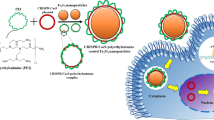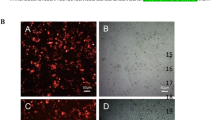Abstract
The improvement of the transfection efficiency of the non-viral-based gene delivery systems is a key issue for the application in gene therapy. We have previously described an archaeal histone-like protein-based (HPhA) gene delivery system and showed that HPhA formed stable non-covalent complexes with nucleic acids and improved their delivery by using β-galactosidase as a reporter gene. In this study, the wild-type p53 gene was transfected into the cancer cells using the HPhA as a vector, and the expression level and the activity of p53 gene were evaluated both in vitro and in vivo. Gene expression was determined by real-time reverse transcriptase-PCR and western blotting analysis. The cellular growth inhibition and apoptosis of HPhA-mediated p53 transfection were assessed by XTT (sodium 3′-[1-(phenylaminocarbonyl)-3,4-tetrazolium]-bis(4-methoxy-6-nitro)benzene sulfonic acid hydrate) assay and annexin V–FITC (fluorescein isothiocyanate) staining, respectively. Further more, transfection of HPhA/p53 into CNE (nasopharyngeal carcinoma cell line)-xenografted nude mice was performed and tumor growth was measured. The present study demonstrates that HPhA enhances the efficiency of p53 gene transfer and antitumor activity compared with the widely used Lipofectamine. These results demonstrate that HPhA enhances the in vitro and in vivo efficiency of p53 gene transfer and suggest that it may be served as a promising tool for gene delivery and gene therapy.
This is a preview of subscription content, access via your institution
Access options
Subscribe to this journal
Receive 12 print issues and online access
$259.00 per year
only $21.58 per issue
Buy this article
- Purchase on Springer Link
- Instant access to full article PDF
Prices may be subject to local taxes which are calculated during checkout







Similar content being viewed by others
References
Cross D, Burmester JK . Gene therapy for cancer treatment: past, present and future. Clin Med Res 2006; 4: 218–227.
Conwell CC, Huang L . Recent advances in non-viral gene delivery. Adv Genet 2005; 53: 1–18.
Bottger M, Zaitsev SV, Otto A, Haberland A, Vorob’ev VI . Acid nuclear extracts as mediators of gene transfer and expression. Biochim Biophys Acta 1998; 1395: 78–87.
Balicki D, Putnam CD, Scaria PV, Beutler E . Structure and function correlation in histone H2A peptide-mediated gene transfer. Proc Natl Acad Sci USA 2002; 99: 7467–7471.
Haberland A, Knaus T, Zaitsev SV, Buchberger B, Lun A, Haller H et al. Histone H1-mediated transfection: serum inhibition can be overcome by Ca2+ ions. Pharm Res 2000; 17: 229–235.
Singh D, Rigby PW . The use of histone as a facilitator to improve the efficiency of retroviral gene transfer. Nucleic Acids Res 1996; 24: 3113–3114.
Balicki D, Reisfeld RA, Pertl U, Beutler E, Lode HN . Histone H2A-mediated transient cytokine gene delivery induces efficient antitumor responses in murine neuroblastoma. Proc Natl Acad Sci USA 2000; 97: 11500–11504.
Balicki D, Reisfeld RA, Pertl U, Beutler E, Lode HN . A recombinant H1 histone-based system for efficient delivery of nucleic acids. J Biotechnol 2003; 105: 215–226.
Kaouass M, Beaulieu R, Balicki D . Histonefection: novel and potent non-viral gene delivery. J Controlled Release 2006; 113: 245–254.
Hariton-Gazal E, Rosenbluh J, Graessmann A, Gilon C, Loyter A . Direct translocation of histone molecules across cell membranes. J Cell Sci 2003; 116: 4577–4586.
Rosenbluh J, Hariton-Gazal E, Dagan A, Rottem S, Graessmann A, Loyter A . Translocation of histone proteins across lipid bilayers and mycoplasma membranes. J Mol Biol 2005; 345: 387–400.
Weng L, Feng Y, Ji X, Cao S, Kosugi Y, Matsui I . Recombinant expression and characterization of an extremely hyperthermophilic archaeal histone from Pyrococcus horikoshii OT3. Protein Expr Purif 2004; 33: 145–152.
Li T, Sun F, Ji X, Feng Y, Rao Z . Structure based hyperthermostability of archaeal histone HPhA from Pyrococcus horikoshii. J Mol Biol 2003; 325: 1031–1037.
Weng L, Liu D, Li Y, Cao S, Feng Y . An archaeal histone-like protein as an efficient DNA carrier in gene transfer. Biochim Biophys Acta 2004; 1702: 209–216.
Wang F, Liang K, Yin W . Radiation-induced apoptosis of two nasopharyngeal carcinoma cell lines. Chinese J Oncol 1998; 20: 119–121.
Mizuguchi H, Nakagawa T, Nakanishi M, Imazu S, Nakagawa S, Mayumi T . Efficient gene transfer into mammalian cells using fusogenic liposome. Biochem Biophys Res Commun 1996; 218: 402–407.
Zhou XH, Klibanov AL, Huang L . Lipophilic polylysines mediate efficient DNA transfection in mammalian cells. Biochim Biophys Acta 1991; 1065: 8–14.
Sun JM, Wiaderkiewicz R, Ruiz-Carrillo A . Histone H1 in the control of DNA synthesis and cell proliferation. Science 1989; 245: 68–71.
Megee PC, Morgan BA, Smith MM . Histone H4 and the maintenance of genome integrity. Genes Dev 1995; 9: 1716–1727.
Brown DT, Alexander BT, Sittman DB . Differential effect of H1 variant overexpression on cell cycle progression and gene expression. Nucleic Acids Res 1996; 24: 486–493.
Brown DT, Gunjan A, Alexander BT, Sittman DB . Differential effect of H1 variant overproduction on gene expression is due to differences in the central globular domain. Nucleic Acids Res 1997; 25: 5003–5009.
Wolf JK, Mills GB, Bazzet L, Bast Jr RC, Roth JA, Gershenson DM . Adenovirus-mediated p53 growth inhibition of ovarian cancer cells is independent of endogenous p53 status. Gynecol Oncol 1999; 75: 261–266.
Shono T, Tofilon PJ, Schaefer TS, Parikh D, Liu TJ, Lang FF . Apoptosis induced by adenovirus-mediated p53 gene transfer in human glioma correlates with site-specific phosphorylation. Cancer Res 2002; 62: 1069–1076.
Kojima Y, Honda K, Kotegawa H, Kushihata F, Kobayashi N, Liu B et al. Adenovirus-mediated p53 gene transfer to the bile duct by direct administration into the bile in a rat cholangitis model. J Surg Res 2005; 128: 126–131.
Kim CK, Choi EJ, Choi SH, Park JS, Haider KH, Ahn WS . Enhanced p53 gene transfer to human ovarian cancer cells using the cationic nonviral vector, DDC. Gynecol Oncol 2003; 90: 265–272.
Nakase M, Inui M, Okumura K, Kamei T, Nakamura S, Tagawa T . p53 gene therapy of human osteosarcoma using a transferrin-modified cationic liposome. Mol Cancer Ther 2005; 4: 625–631.
Acknowledgements
We are grateful to Li-Xue Shi for her helpful contributions. This study was supported by grants from National Natural Science Foundation of China (30571642) and the 973 programs (2004CB719606).
Author information
Authors and Affiliations
Corresponding authors
Rights and permissions
About this article
Cite this article
Li, Y., Wang, R., Zhang, G. et al. An archaeal histone-like protein mediates efficient p53 gene transfer and facilitates its anti-cancer effect in vitro and in vivo. Cancer Gene Ther 14, 968–975 (2007). https://doi.org/10.1038/sj.cgt.7701086
Received:
Revised:
Accepted:
Published:
Issue Date:
DOI: https://doi.org/10.1038/sj.cgt.7701086



